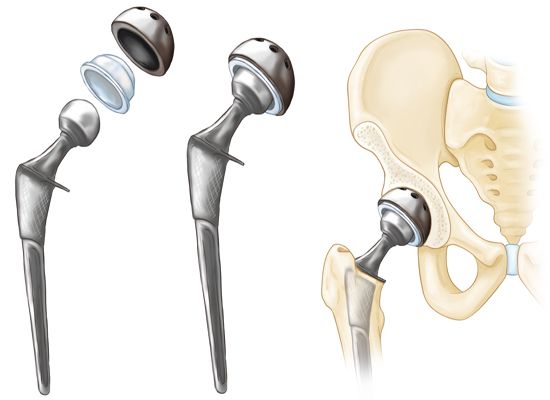Total Hip Replacements
Total Hip Replacements: A Solution for Lasting Hip Pain Relief
Hip replacement surgery is reserved for those who have serious hip injury. The hip surgeon removes damaged cartilage and bone from your hip joint and replaces it with new, man-made pieces during a hip replacement. This can help relieve pain, reduce hip stiffness, and enhance the function of your hip joint, as well as improve your walking and other activities. If physical therapy, medications, and exercise aren’t helping your hip issues and discomfort, your doctor may prescribe it.
Hip dislocation is the most common post-surgery problem. The ball of a man-made hip might come out of its socket since it is smaller than the original joint. Blood clots and infections might potentially occur as a result of the procedure. Certain activities, such as running and high-impact sports, may be prohibited after a hip replacement.

What is a total hip replacement?

A complete hip replacement is a surgical treatment that replaces the damaged cartilage and bone of the hip joint with artificial materials (Artificial Hip). A ball and socket joint is the standard hip joint. The socket is a “cup-shaped” pelvic bone called the acetabulum. The ball is the thigh bone’s head (femur). Total hip replacement entails surgically removing the damaged ball and socket and replacing them with a metal ball and stem put into the femur bone, as well as an artificial plastic cup socket. The artificial metallic ball and stem are referred to as the “prosthesis.” After putting the prosthesis into the central core of the femur, it is secured with methylmethacrylate, a bone cement. A “cementless” prosthesis, which contains small openings that enable bone ingrowths from the natural femur into the prosthesis stem, is also employed. A “cementless” prosthesis is also used, which has tiny pores that allow bone ingrowths from the native femur into the prosthesis stem. This “cementless” hip is thought to last longer and is preferred for younger patients.
Candidates for total hip replacement
Total hip replacements are most typically performed due to progressively increasing severe arthritis in the hip joint. Degenerative arthritis (osteoarthritis) of the hip joint is the most prevalent kind of arthritis that leads to complete hip replacement. This kind of hip arthritis is commonly associated with age, congenital hip joint abnormalities, or past hip joint trauma. Other disorders that may necessitate complete hip replacement include hip joint bony fractures, rheumatoid arthritis, and hip bone death (aseptic necrosis). Hip fractures, medicines (such as prednisone and prednisolone), drunkenness, and illnesses can all induce hip bone necrosis (such as systemic lupus erythematosus).
Chronic discomfort that worsens with time, as well as impairments in everyday activity such as walking, climbing stairs, and even rising from a sitting posture, are all reasons to consider a total hip replacement. Because restored hip joints might fail over time, deciding whether or not to do complete hip replacement is a difficult issue, especially in younger individuals. Replacement is usually considered when pain becomes severe enough to interfere with normal activity despite the use of anti-inflammatory and/or pain medicines. A complete hip joint replacement is an elective treatment, which means it was chosen over other options. It is a choice that is taken after considering the prospective risks and advantages. A solid comprehension of both the technique and the expected outcome is essential for decision-making.

